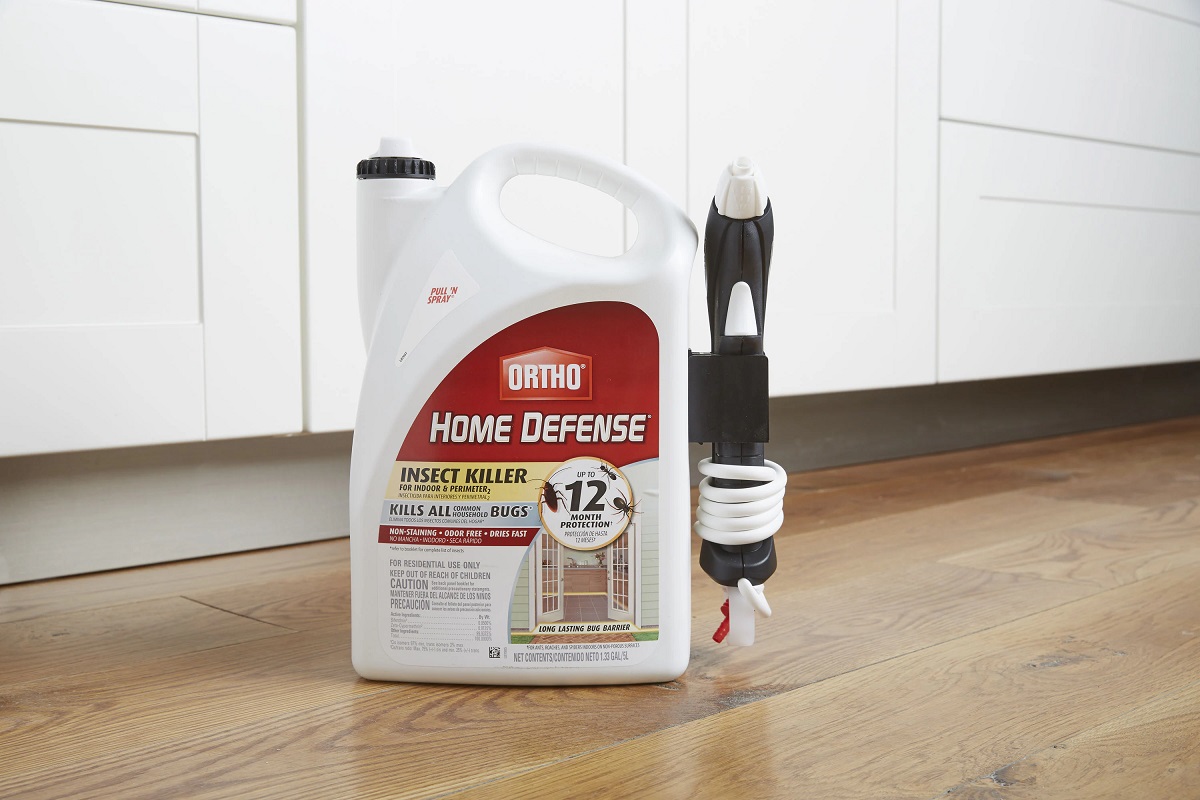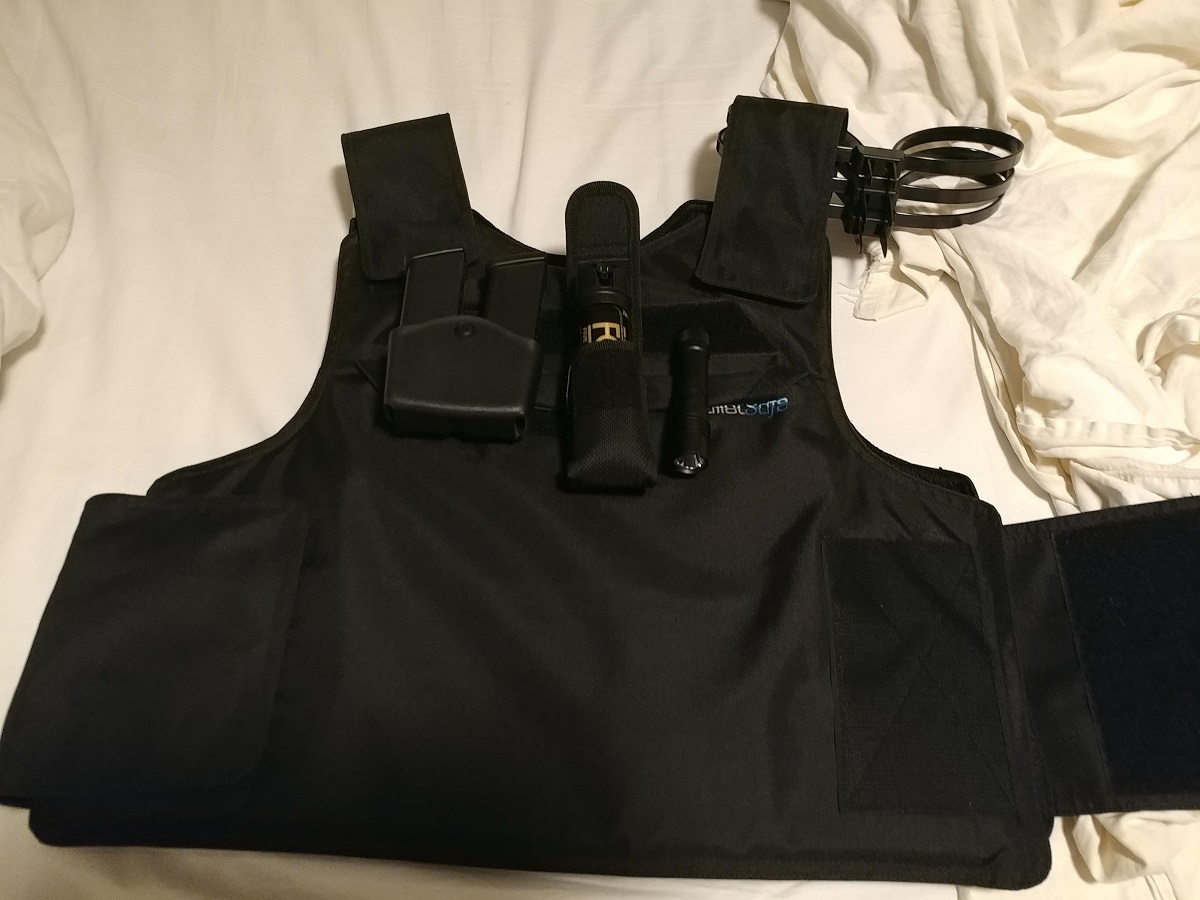Home>Home Security and Surveillance>What To Do In Home Defense: Kill Or Wound?


Home Security and Surveillance
What To Do In Home Defense: Kill Or Wound?
Modified: March 6, 2024
Discover effective strategies for home defense and make an informed decision on whether to incapacitate or injure intruders. Enhance your home security and surveillance with these expert tips.
(Many of the links in this article redirect to a specific reviewed product. Your purchase of these products through affiliate links helps to generate commission for Storables.com, at no extra cost. Learn more)
Introduction
Welcome to the world of home defense! As the saying goes, “Your home is your castle,” and ensuring its safety and security is a top priority for many homeowners. In an uncertain world filled with potential threats, having proper protection and surveillance in place has become essential.
From burglaries to home invasions, the need for home security and surveillance systems has skyrocketed in recent years. These systems provide you with peace of mind, knowing that you and your loved ones are protected. But what if the unthinkable happens, and you find yourself confronted with an intruder in your home? What do you do? Do you aim to kill or wound?
Understanding the intricacies of home defense is crucial. It involves evaluating the threat, considering legal implications, and choosing the best course of action based on your personal beliefs and values. In this article, we will delve deep into the topic of home defense and surveillance, exploring the dilemmas and decisions homeowners face in the face of an intruder.
Before we dive into the moral and ethical dilemma of killing or wounding, let’s take a moment to understand the importance of evaluating the threat. Knowing the level of danger you are up against will help you make an informed decision and take appropriate action.
Key Takeaways:
- Home defense involves evaluating threats, understanding legal implications, and prioritizing safety. It’s crucial to balance personal beliefs and values with the goal of protecting loved ones within the bounds of the law.
- Training, preparedness, and continuous reassessment are essential for effective home defense. Prioritizing safety and well-being while staying informed and seeking professional guidance is key.
Read more: What Does Home Defense Kill
Understanding Home Defense
Home defense goes beyond simply installing a security system or locking your doors and windows. It is a comprehensive approach to protecting your home and loved ones from potential threats. This includes having an understanding of the different layers of security, such as physical barriers, surveillance systems, and personal defense measures.
Physical barriers are the first line of defense in home security. This includes sturdy doors and windows, reinforced locks, and even security gates. These barriers act as deterrents, making it more difficult for intruders to gain entry into your home.
Surveillance systems play a crucial role in home defense. From basic security cameras to advanced smart systems, they provide you with real-time information about any suspicious activity in and around your property. This gives you the opportunity to take necessary actions or alert the authorities.
In addition to physical barriers and surveillance, personal defense measures also play a vital role in home defense. This includes personal safety devices, self-defense training, and knowing how to effectively use items in your home as weapons in case of an emergency.
Understanding the importance of these layers of security is essential as it helps you determine the level of threat posed by an intruder. This, in turn, influences the decision you make in defending your home.
When evaluating the threat, consider factors such as the number of intruders, their intentions, and potential weapons they may possess. This assessment forms the basis of deciding whether to confront and neutralize the threat or seek a safer alternative.
Now that we have a basic understanding of home defense, let’s explore the legal considerations surrounding it.
Evaluating the Threat
When faced with an intruder in your home, one of the first steps in determining the appropriate response is evaluating the threat. By assessing the situation, you can make informed decisions on how to best protect yourself and your family.
One important factor to consider is the number of intruders. Are you facing a single individual or a group? Multiple intruders may present a higher level of danger and necessitate a different response than a lone intruder. Assessing their capabilities, such as whether they are armed or unarmed, is also crucial in understanding the level of threat they pose.
Next, consider the intruder’s intentions. Are they simply looking for an opportunity to steal valuable items, or do they show signs of violence or aggression? Understanding their motivations can help guide your decision-making process.
It’s important to keep in mind that eliminating the threat should be your primary objective in a home defense situation, but it’s equally important to prioritize the safety and well-being of yourself and your loved ones. If you can safely retreat to a secure location and contact the authorities, that may be the best course of action in certain circumstances.
Another aspect of evaluating the threat is assessing your own capabilities and limitations. Are you trained in self-defense? Do you have access to personal defense tools or firearms? Understanding your own readiness and skills will help guide your response and give you confidence in your ability to handle the situation.
Ultimately, evaluating the threat is a complex process that requires quick thinking and the ability to assess the situation accurately. It’s important to remember that every home defense scenario is unique, and there is no one-size-fits-all approach. By taking the time to assess the threat, you can make better decisions that prioritize your safety and the safety of your loved ones.
Now that we understand the importance of evaluating the threat, let’s explore the legal considerations of home defense.
Legal Considerations
In any home defense situation, it is crucial to understand the legal implications of your actions. While your priority is to protect yourself and your loved ones, it is essential to act within the boundaries of the law.
The laws surrounding home defense can vary depending on the jurisdiction, so it’s important to familiarize yourself with the laws specific to your area. Generally, self-defense laws allow individuals to use reasonable force to defend themselves or others against immediate threats of harm.
It’s important to understand the concept of “reasonable force.” This means using the amount of force necessary to neutralize the threat without excessive or gratuitous violence. The level of force deemed reasonable can vary depending on the circumstances, including the severity of the threat and the possibility of retreat.
While some jurisdictions have a “stand your ground” principle that allows individuals to defend themselves without having a duty to retreat, others have a “duty to retreat” requirement. This means that if you have the opportunity to safely escape the situation, it may be legally expected that you do so.
Furthermore, some jurisdictions differentiate between using force to protect your property versus using force to protect yourself or others. Understanding these distinctions is important to avoid legal repercussions.
It is essential to consult with local law enforcement or legal professionals to understand the specific laws and regulations in your area. Familiarize yourself with any requirements or restrictions regarding the use of firearms or other self-defense tools, as well as any potential civil liabilities that may arise from your actions.
Remember, the goal of home defense is to protect yourself and your loved ones while remaining within the bounds of the law. Understanding the legal considerations surrounding self-defense will help you make informed decisions and ensure that you are acting responsibly.
Now that we have explored the legal aspects of home defense, let’s dive into the ultimate goal of defending your home.
The Goal of Home Defense
The primary goal of home defense is to ensure the safety and protection of yourself and your loved ones. It is about creating a secure environment within the confines of your own home, where you can feel safe and secure.
While the methods and strategies of home defense may vary, the ultimate objective remains the same: to prevent harm or danger from entering your living space. This involves deterring potential threats, detecting any unauthorized access, and responding appropriately to ensure the well-being of everyone inside the home.
Creating a safe living environment starts with implementing effective security measures such as alarms, cameras, and secure locks on doors and windows. These physical barriers serve as a deterrent, making it less likely for intruders to target your home.
Equally important is the implementation of a comprehensive surveillance system. Surveillance cameras, both indoor and outdoor, provide real-time monitoring and evidence in the event of suspicious activity or a security breach. This not only acts as a deterrent but also helps authorities in identifying and apprehending suspects.
However, the goal of home defense goes beyond physical security measures. It also involves being prepared mentally and emotionally to respond to potential threats. This includes having emergency plans in place, conducting family safety drills, and ensuring that everyone in the household is aware of how to react in case of an intrusion.
Above all, the overarching goal of home defense is to protect life. While material possessions are valuable, the safety and well-being of yourself and your loved ones should always take precedence. It is essential to consider the potential risks and threats that may arise and have the necessary measures in place to mitigate them.
By achieving the goal of home defense, you can create an environment where you have peace of mind, knowing that you have taken the necessary steps to protect your home and those within it.
Now that we understand the goal of home defense, let’s delve into the dilemma that many homeowners face: whether to kill or wound in a self-defense situation.
Read more: What To Do After A Home Defense Situation
The Dilemma: Kill or Wound?
When faced with an intruder in your home, one of the most challenging decisions you may have to make is whether to kill or wound. This moral and ethical dilemma poses a complex question that requires careful consideration.
On one hand, the instinctive response may be to eliminate the threat entirely by opting for lethal force. The rationale behind this approach is that a neutralized intruder can no longer pose a danger to you or your loved ones. This perspective emphasizes the importance of ensuring your safety by taking decisive action.
On the other hand, some argue that choosing to wound rather than kill aligns with a more compassionate approach. By incapacitating the intruder without causing fatal harm, the hope is that they can be stopped and apprehended without loss of life. This viewpoint places an emphasis on the preservation of life whenever possible and highlights the value of human compassion in difficult situations.
The choice between killing and wounding is subjective and depends on various factors, including the level of threat posed by the intruder, your own personal beliefs and values, and the legal implications involved. It is crucial to consider the consequences of your actions and the potential ramifications that they may have.
It’s important to note that while the decision may ultimately fall on you, it is advised to consult local laws and seek professional guidance on the legality and repercussions of your choices in your specific jurisdiction.
Additionally, it’s essential to be aware that the high-stress nature of a home defense situation can significantly impact decision-making. Adrenaline, fear, and a sense of urgency can cloud judgment and rational thinking. This reinforces the significance of training and preparedness in ensuring that you can respond appropriately in such circumstances.
Ultimately, the choice between killing or wounding is a personal one. It is a decision that should be made based on the specific circumstances, your beliefs, and an understanding of the potential consequences. It is crucial to prioritize your safety and the safety of your loved ones while considering the moral and ethical implications of your actions.
In the next sections, we will explore the arguments for both killing and wounding in home defense situations, as well as the ethical and moral perspectives surrounding this dilemma.
Arguments for Killing in Home Defense
When considering the use of lethal force in a home defense situation, there are several arguments that support the choice of killing as a response:
- Ensuring Personal Safety: The primary aim of home defense is to protect yourself and your loved ones. By eliminating the threat completely, you guarantee your safety and minimize the possibility of harm.
- Stopping Immediate Danger: In high-stress situations, it may be difficult to accurately assess the intentions and capabilities of an intruder. Opting for lethal force ensures that the threat is neutralized immediately, removing the potential for further harm or escalation.
- Preventing Future Harm: By eliminating an intruder through lethal force, you prevent them from returning to your home or potentially targeting others in the future. This approach prioritizes the safety of not only your household but also the wider community.
- Clarity in Self-Defense Laws: In some jurisdictions, self-defense laws may provide clearer legal protection when lethal force is used to neutralize an intruder. This can alleviate potential legal complications and ensure that you are within your rights when defending your home.
- Psychological Impact: The act of killing an intruder in self-defense may serve as a deterrent to others who might consider targeting your home. The reputation of being willing to protect yourself and your property can discourage potential threats.
It’s essential to note that while these arguments may support the use of lethal force in home defense situations, they should be weighed carefully against moral and ethical considerations. The decision to take a life should not be taken lightly and should only be considered when there is an imminent and severe threat to you or your loved ones.
In the next section, we will explore the arguments for wounding in home defense scenarios.
When it comes to home defense, the goal should be to stop the threat. If you have to use force, aim to neutralize the threat by shooting to stop, not to kill. Always prioritize your safety and the safety of your loved ones.
Arguments for Wounding in Home Defense
When faced with a home defense situation, there are arguments that support the choice of wounding an intruder rather than opting for lethal force:
- Prioritizing Life: Choosing to wound instead of kill aligns with a belief in the value and sanctity of human life. It allows for the possibility of the intruder receiving medical treatment and a chance for rehabilitation.
- Minimizing Legal Repercussions: In some jurisdictions, using lethal force may carry higher legal risks and potential complications. Opting to wound the intruder can help mitigate potential legal consequences while still neutralizing the immediate threat.
- Moral and Ethical Considerations: Taking a life, even in self-defense, can have profound psychological and emotional impact. By choosing to wound, you may avoid the long-lasting psychological consequences associated with causing a fatality.
- Potential for Capturing the Intruder: Wounding the intruder may increase the likelihood of capturing and apprehending them. This allows law enforcement to investigate their motives and potentially prevent further crimes.
- Demonstrating Human Compassion: Opting for non-lethal force demonstrates a commitment to preserving life whenever possible. It showcases a sense of empathy and compassion, even in challenging circumstances.
It’s important to note that the decision to wound an intruder should be based on a thorough evaluation of the situation and an understanding of the potential risks involved. Wounding an intruder may not always be a viable option, especially if it compromises your safety or the safety of your loved ones.
Ultimately, the choice between killing and wounding is subjective and depends on various factors, including the level of threat posed by the intruder, your personal beliefs, and the legal considerations specific to your jurisdiction.
Now that we have explored the arguments for both killing and wounding, let’s delve into the ethical and moral perspectives surrounding this dilemma in home defense situations.
Ethical and Moral Perspectives
The question of whether to kill or wound in a home defense scenario raises critical ethical and moral considerations. There are divergent perspectives on this issue, influenced by individual beliefs, values, and cultural backgrounds.
On one hand, proponents of lethal force argue that the protection of oneself and loved ones outweighs any ethical or moral concerns. They believe that the right to self-defense justifies taking the life of an intruder who poses a serious threat. This perspective views self-preservation as a fundamental moral imperative.
On the other hand, advocates for non-lethal force emphasize the value of human life and the moral obligation to show compassion, even in self-defense situations. They argue that taking a life should be an absolute last resort when all other options have been exhausted.
Some ethical frameworks, such as certain religious or philosophical beliefs, promote the principle of non-violence and advocate for minimizing harm whenever possible. These perspectives argue for finding alternative methods to neutralize the threat and resolve the situation without causing fatal harm.
Additionally, the concept of proportionality plays a role in the ethical and moral evaluation of self-defense actions. Proportionality considers the balance between the harm inflicted on the intruder and the severity of the perceived threat. Advocates for this perspective argue that the response should be proportional to the threat, aiming to neutralize rather than fatally harm the intruder.
It is important to acknowledge that the high-stress nature of a home defense situation may impact one’s ability to adhere strictly to ethical or moral principles. Adrenaline, fear, and the instinct for self-preservation can influence decision-making in ways that may deviate from one’s normal ethical framework.
It is advisable to reflect on one’s own ethical and moral values beforehand and consider seeking guidance from trusted sources, such as religious leaders, counselors, or ethical experts, to navigate the dilemmas that arise in home defense situations.
Ultimately, the decision to kill or wound in a self-defense scenario is deeply personal and dependent on the individual’s ethical and moral compass. It is a decision that carries significant weight and should be made with careful consideration of the potential consequences.
In the following sections, we will explore the psychological impact of home defense situations and the practicality of wounding as a response strategy.
Read more: How Quickly Does Home Defense Kill Roaches
Psychological Impact
Engaging in a home defense situation, whether it involves using lethal or non-lethal force, can have a profound psychological impact on those involved. The high-stress nature of such incidents can lead to a range of emotional and psychological responses.
One of the primary psychological effects is the experience of fear and heightened arousal. The intense adrenaline rush and fear of personal harm can cause individuals to enter a state of hyperarousal, which can impair decision-making and fine motor skills. This can make it challenging to accurately assess the situation and make rational choices.
Additionally, the act of physically harming another person, even in self-defense, can generate a range of emotional responses. It is not uncommon for individuals to experience guilt, remorse, or even post-traumatic stress following a home defense scenario. These emotional reactions can have lasting effects on mental well-being.
The psychological impact can manifest differently for each individual, depending on their resilience, prior experiences, and support structures. Some may experience feelings of empowerment and relief for successfully defending their home and loved ones. Others may grapple with feelings of guilt or moral conflict, even if their actions were justified.
It is essential to recognize and address the potential psychological impact of a home defense situation. Seeking support from mental health professionals, support groups, or counseling services can help individuals process the emotional aftermath and cope with any lingering psychological effects.
Preparing for the psychological impact before a potential home defense scenario is also crucial. Engaging in self-defense training, developing a strong support network, and practicing stress management techniques can enhance psychological resilience and help individuals navigate these difficult situations.
Ultimately, the psychological impact of engaging in a home defense situation should not be underestimated. It is imperative to prioritize mental well-being and seek appropriate support to address any psychological consequences that may arise.
Now let’s explore the practicality of wounding as a response strategy in home defense scenarios.
The Practicality of Wounding
Considering the practicality of wounding as a response strategy in home defense scenarios involves assessing its effectiveness and potential advantages compared to other options, such as using lethal force.
One of the primary benefits of choosing to wound an intruder is the potential for incapacitation without causing fatal harm. By neutralizing the threat through non-lethal means, you reduce the risk of inflicting severe injury or loss of life. This can be particularly valuable if the intruder is unarmed or poses a threat that does not necessarily warrant lethal force.
Non-lethal force options, such as tasers, pepper sprays, or non-lethal projectiles, can provide an effective means of temporarily disabling an intruder, allowing you to immobilize them and gain control of the situation. These tools are designed to temporarily incapacitate the individual, giving you the opportunity to retreat or seek additional help.
Another practical consideration is the potential legal and ethical advantages of choosing to wound rather than kill. In some jurisdictions, using non-lethal force in self-defense may carry less legal risk and have fewer legal complications. Additionally, adhering to the principle of preserving life whenever possible may align with personal ethical beliefs and values.
However, it is important to recognize the limitations of wounding as a response strategy. Depending on the circumstances, incapacitating an intruder without causing fatal harm may not always be feasible, especially if there are multiple assailants or if the intruder is armed with a deadly weapon.
The practicality of wounding also depends on various factors, such as your proximity to the intruder, your own physical abilities, and the effectiveness of the non-lethal force option chosen. It is crucial to choose tools or techniques that you are comfortable and proficient in using, as well as understanding their limitations.
Additionally, it is important to consider the potential psychological impact of wounding an intruder. Even non-lethal force can result in significant trauma and emotional distress for both parties involved. It is essential to be prepared for the aftermath of such an incident and seek appropriate support if needed.
In summary, the practicality of wounding as a response strategy in home defense scenarios depends on the specific circumstances, individual capabilities, and the availability of non-lethal force options. While it may offer certain advantages, it is crucial to balance practical considerations with personal safety and the overall goal of protecting oneself and loved ones.
In the next section, we will explore the importance of training and preparedness in effectively responding to home defense situations.
Evaluating the Aftermath
After a home defense situation, it is essential to evaluate the aftermath of the incident. This assessment involves considering various factors, including the physical, emotional, and legal aspects of the encounter.
One of the primary considerations is the physical aftermath. This involves assessing any injuries or damage that may have occurred during the incident. It is crucial to prioritize medical attention for yourself and anyone else who may require it. Even if you have successfully defended your home, it is important to seek medical evaluation to ensure there are no hidden injuries that need treatment.
After addressing the physical aspect, it is important to evaluate the emotional impact of the event. Home defense situations can be highly stressful and traumatic, and it is normal to experience a range of emotions such as fear, anxiety, or guilt. Taking the time to process these emotions and seeking support from loved ones, professionals, or support groups can be vital in coping with the aftermath and promoting emotional healing.
From a legal standpoint, it is important to review and assess the actions taken during the incident. Consulting with legal professionals and considering the laws and regulations specific to your jurisdiction can help you understand the potential legal implications and ensure that you are within your rights and responsibilities.
Evaluating the aftermath also involves assessing the effectiveness of your home defense measures. Were there any weaknesses or vulnerabilities that were exposed during the incident? Identifying these areas allows you to make necessary improvements to your security system or personal defense strategies to enhance overall safety in the future.
Furthermore, it is important to communicate and cooperate with law enforcement authorities. Providing them with accurate information and cooperating in any investigations contributes to a thorough understanding of the incident and helps ensure that justice is served.
Finally, it is crucial to consider the long-term impact of the home defense situation on your overall well-being. Seek the necessary support and resources to address any psychological, emotional, or even financial challenges that may arise from the incident. Taking care of your mental and emotional health is instrumental in recovering and moving forward.
In summary, evaluating the aftermath of a home defense situation involves assessing the physical, emotional, and legal aspects. It is crucial to address any injuries, seek emotional support, understand the legal implications, and make necessary improvements to home defense measures. By actively evaluating the aftermath, you can take appropriate steps to heal, learn, and enhance your preparedness for future scenarios.
Now that we have explored the importance of evaluating the aftermath, let’s discuss the significance of training and preparedness in effectively responding to home defense situations.
Training and Preparedness
When it comes to home defense, training and preparedness are key elements in ensuring an effective response to potential threats. Being well-prepared and equipped with the necessary skills and knowledge can make all the difference in a high-stress situation. Here are some important considerations:
1. Self-Defense Training: Engaging in self-defense training is crucial for developing the physical and mental capabilities to protect yourself and your loved ones. Self-defense classes teach techniques for evasion, blocking, and immobilizing intruders, as well as strategies for assessing threats and making effective decisions under pressure.
2. Familiarity with Home Security Systems: Understanding how to operate your home security system is essential for swift action in case of an intruder. Practice using the alarm, surveillance cameras, and other security features to ensure you are comfortable utilizing them during an emergency.
3. Emergency Planning: Develop an emergency plan that outlines what actions each family member should take in the event of a home invasion. Establish designated safe areas within your home, establish communication protocols, and run drills to ensure everyone is familiar with the plan.
4. Access to Self-Defense Tools: Consider obtaining and becoming proficient in the use of self-defense tools such as pepper spray, stun guns, or batons. Ensure you understand proper handling, maintenance, and legalities surrounding their use in your jurisdiction.
5. Mental and Emotional Preparedness: Prepare yourself mentally and emotionally for a home defense situation. This includes understanding the potential risks, accepting that difficult choices may need to be made, and managing fear and stress through techniques such as deep breathing or visualization exercises.
6. Continuous Practice: Regularly review and practice your self-defense skills and emergency plans. Keep your knowledge and techniques fresh, allowing you to respond more effectively if a home defense situation arises.
7. Stay Informed: Keep up-to-date with the latest advancements in home security technology and self-defense strategies. Attend workshops or seminars that provide insights into best practices and new developments in the field.
8. Engage in Situational Awareness: Develop a habit of maintaining situational awareness in and around your home. Be observant of your surroundings, notice any suspicious activities, and report them to the authorities when necessary.
Remember, training and preparedness are ongoing processes. It is important to regularly reassess your skills, update your plans, and adapt to changing circumstances.
By prioritizing training and preparedness, you increase your ability to respond effectively and confidently to home defense situations. These measures not only enhance your safety but also provide peace of mind for you and your loved ones.
Now, let’s conclude our exploration of home defense and the various aspects to consider when protecting your home and loved ones.
Read more: What To Use For Home Defense
Conclusion
Protecting your home and loved ones is a top priority, and understanding the complexities of home defense is essential in ensuring their safety. Throughout this article, we have explored various aspects of home defense, from evaluating the threat to the legal and ethical considerations surrounding killing or wounding intruders. Here are the key takeaways:
– Understanding home defense involves implementing physical barriers, surveillance systems, and personal defense measures to create a secure living environment.
– Evaluating the threat requires assessing the number of intruders, their intentions, and your own capabilities, while prioritizing safety and well-being.
– Legal considerations vary by jurisdiction, so it’s crucial to familiarize yourself with the laws specific to your area to act within legal boundaries.
– The primary goal of home defense is to protect yourself and loved ones, while minimizing harm and ensuring their safety within the bounds of the law.
– The decision of whether to kill or wound an intruder is subjective, based on factors such as threat level, personal beliefs, and legal implications.
– Ethical and moral perspectives vary, with arguments for both killing and wounding, requiring careful consideration and awareness of potential consequences.
– Engaging in a home defense situation can have a significant psychological impact, necessitating post-incident evaluation and seeking appropriate support.
– The practicality of wounding as a response strategy depends on the circumstances, personal capabilities, and weapons available.
– Evaluating the aftermath involves assessing physical, emotional, and legal aspects, as well as making necessary improvements to security measures.
– Training and preparedness through self-defense training, emergency planning, and continuous practice are crucial in effectively responding to home defense situations.
By understanding these key considerations and taking proactive steps to prepare yourself and your home, you can enhance your ability to respond to potential threats. Balancing these aspects with your own beliefs, values, and legal obligations is vital in making informed decisions during high-stress situations.
Remember, home defense is a complex and ever-evolving field, so staying informed, seeking professional guidance when necessary, and regularly reassessing your preparations are essential. Prioritizing the safety and well-being of yourself and your loved ones should always be at the forefront of your efforts.
With a well-rounded approach to home defense and an emphasis on training, preparedness, and careful decision-making, you can create a safe and secure living environment, providing peace of mind for yourself and those you hold dear.
Frequently Asked Questions about What To Do In Home Defense: Kill Or Wound?
Was this page helpful?
At Storables.com, we guarantee accurate and reliable information. Our content, validated by Expert Board Contributors, is crafted following stringent Editorial Policies. We're committed to providing you with well-researched, expert-backed insights for all your informational needs.












